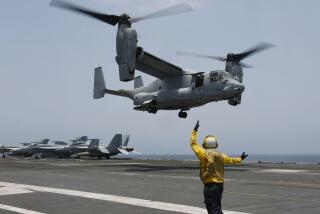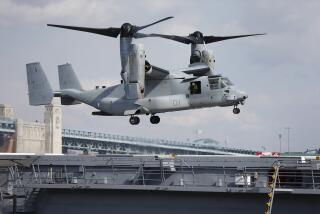The High Price of Being Prepared
- Share via
The midair collision of two military aircraft over Edwards Air Force base on Wednesday continues a disturbing series of crashes that began in September. In just over a month, the losses total 18 lives and 10 planes.
These accidents involved aircraft from three services operating different models while performing widely different missions. They occurred in locations stretching 10,000 miles from California to Africa to the Persian Gulf. Because of these disparate factors, it is unlikely that the investigations now underway will identify any common elements that will lead to safety measures likely to prevent such tragedies.
What the investigations will confirm is that military service carries special risks, even in peacetime. With 1.4 million men and women in uniform engaged in realistic training activities and dangerous operations, including nearly 250,000 of them on foreign turf, casualties become an inevitable cost of keeping our forces in a high state of combat readiness.
According to the latest Defense Department report, 18,370 American servicemen and servicewomen died accidentally during the last 18 years. Until the late 1980s, the accidental death reports contained detailed information listing accidents in 27 categories. This made it possible to form a clear picture of the hazards facing service members daily. Vehicle accidents are the most common cause of death, accounting for almost 63% of all accidental deaths. Aircraft crashes are next, with 16% of the fatalities. Drowning deaths constituted 7%, falls were 3% and gunshots were 2%. Fire, explosions, electrocution, parachute accidents, loss overboard at sea and suffocation are other common causes of death. Four percent of all accidental deaths were recorded as “cause undetermined” in the last detailed report.
The overwhelming impression is of lives lived under tension in perilous environments. Inherently dangerous conditions and high risks are created by the use of explosives, high performance aircraft, complex machinery, heavy vehicles, guns and rockets, often in conditions of darkness and bad weather. The ever-present threat of hostile action on foreign soil and seas adds another level of stress and the combined pressures inevitably take a toll in the form of accidents.
Another measure of the demands of military life, even in peacetime, is seen in the fact that since 1979 there have been 1,709 homicides and 4,150 suicide deaths by service members. These violent acts are too often the result of the pressures imposed by the rigorous conditions of service life, compounded by separation from families and friends. The appalling fact is that over the last 18 years, about 1,350 violent, noncombat-related deaths occurred each year in the armed services.
Fortunately, the news is not all bad. Service deaths due to accidents are decreasing, due primarily to fewer people on active duty and, apparently, improved safety programs. Because the Pentagon no longer provides detailed lists of the causes of accidents in the services, it is impossible to say precisely why the rate has declined significantly since 1980.
Aviation safety has been improving steadily. Until the sudden, inexplicable loss of four aircraft in one week in September, the Air Force had been enjoying a banner year with a record low of only 54 major accidents since Oct. 1, 1996. Only 30 years ago, military aircraft accident rates were calculated in terms of accidents per 10,000 hours of flight time. The safety goal then was two accidents per 10,000 hours and it is now two per 100,000 hours, a tenfold improvement in safety.
However it has been achieved, the services now suffer far fewer losses due to accidents. In 1996, there were only 511 accidental deaths, 63 homicides and 198 suicides, a total of 772 violent, noncombat-related deaths compared to the 18-year average of 1,350.
While such improvement is welcome, it remains a high price to pay to maintain global military forces in readiness to fight two regional conflicts simultaneously. Nevertheless, this is the official military strategy of the United States, and it requires our service men and women to engage in innately perilous actions where accidents are inevitable. Just as the nation is willing to invest $270 billion during 1998 in preparations for war, we must face the fact that America also is investing the lives and well-being of our service members in the same effort. This recent shocking series of aircraft accidents is another sober reminder that too many of them will be called on to pay far more than money.
More to Read
Sign up for Essential California
The most important California stories and recommendations in your inbox every morning.
You may occasionally receive promotional content from the Los Angeles Times.










